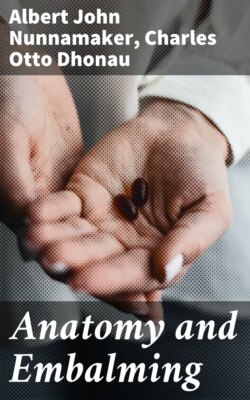Читать книгу Anatomy and Embalming - Charles Otto Dhonau - Страница 32
На сайте Литреса книга снята с продажи.
The Skin.
Оглавление—The skin or integument (intego, to cover) is the outside covering of the human body. It is the first tissue that is cut when operating upon the body.
Fig. 2—A cross section of the skin. (Gray)
The skin is the seat of the organs of touch. The multitudes of sensory nerve endings convey the sensations of temperature, pressure and pain to the brain, thus informing the brain at all times, to keep the body from harm, and in a strong and healthful condition.
The skin is also the regulator of the body temperature, for connected with the skin are sweat glands, and sebaceous glands, each having important excretory functions.
The skin is also a protective coat, very elastic, and varies greatly in thickness. It is thinnest in the eyelids and thickest over the back of the neck, back of the shoulders, palms of the hands and the soles of the feet.
The color of the skin depends upon two things, first, on the pigment, which is found, one of the discriminating points between the races, named by the color of the skin as white, black, yellow, etc.; second, the color depends upon the amount of blood in circulation, the deepest hue being in the parts exposed to the air, light and the varied temperatures. Besides these the color of the skin varies with age, pinkest in the infant and becoming yellow with old age. It varies with exposure and with climate, the people living in the north having a much different complexion than those living in the south under the tropical sun. The color of the skin also varies with certain diseases, being extremely pale in anaemia, brown in Addison's disease, and yellow in jaundice.
The skin can be said to be moveable, although in places it is attached firmly to the underlying structures, especially on the scalp, the soles of the feet, and the palms of the hands.
Upon close examination the skin discloses a multitude of openings, creases, furrows, depressions, folds and hairs.
A dimple is a permanent pit or depression due to the adhesion of the surface to parts beneath.
Structure.—The skin consists of two intimately connected structures, the one is the true skin, corium, or dermis and is the deepest layer of the skin; and the other is the false skin, cuticle, or epidermis, and is the outermost layer of the skin.
The true skin, is composed mostly of connective tissues and elastic fibers. It is the real seat of the sense of touch, for it is here that the sensory nerves have their termination. In this layer we also have the termination of the minute capillaries of the skin.
The false skin, contains no blood vessels or nerves, and being without these it is practically dead tissue, and to illustrate this fact one can take a needle and run it through this outside layer without the least pain or the drawing of blood.
The false skin is the part which slips off in case of skin slip. In as much as the minute capillaries end at the termination of the true skin, when putrefaction and fermentation begin there is an oozing of water from the capillaries and the surrounding tissues, between the two layers of skin, causing a blister to form, and known as skin slip.
At the lowest part of the false skin is a layer of germinal cells, from which all the other cells are derived, and becoming more flattened and horny as they are pushed farther away from the blood supply; and also a layer of pigment cells, which give the discriminating color to the skin.
In the skin are seen numerous sebaceous and sweat glands.
The sweat glands are the organs by which a large portion of the aqueous and gaseous materials are excreted by the skin. Sweat glands are found in almost every portion of the skin, and are situated in small pits below the surface of the skin, surrounded by a quantity of adipose tissue or fat. They are small, round, reddish bodies, consisting of a single tubule, convoluted in form, which extends up through the skin and opens on the surface. The size of these glands, of course, vary, being especially large in those regions where the flow of perspiration is copious as in the axilla.
The sebaceous glands are small, sacculated, glandular organs, lodged in the substance of the skin. They are found in most parts of the skin and are usually connected with the hair follicles. Each gland consists of a single duct, more or less capacious, which terminates in a cluster of small secreting pouches or saccules. These glands secrete an oily fluid, which keeps the skin soft and also oils the shaft of the hair.
